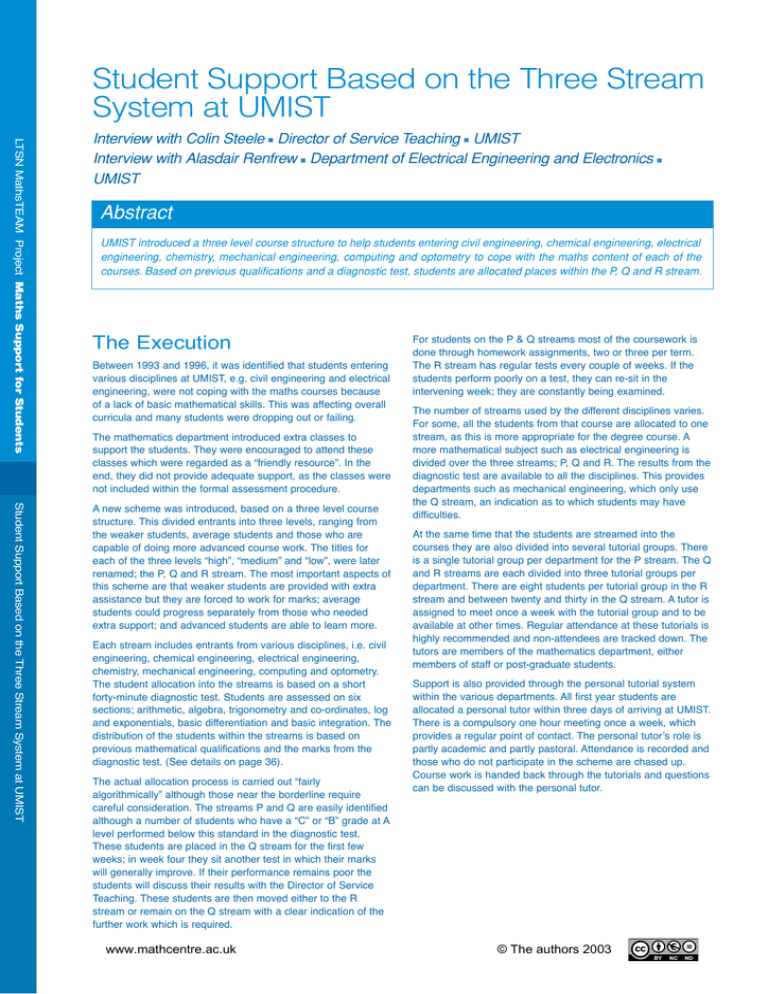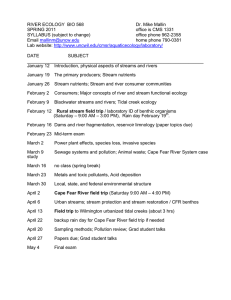Abstract
advertisement

Student Support Based on the Three Stream System at UMIST LTSN MathsTEAM Project Maths Support for Students Interview with Colin Steele ■ Director of Service Teaching ■ UMIST Interview with Alasdair Renfrew ■ Department of Electrical Engineering and Electronics ■ UMIST Student Support Based on the Three Stream System at UMIST A new scheme was introduced, based on a three level course structure. This divided entrants into three levels, ranging from the weaker students, average students and those who are capable of doing more advanced course work. The titles for each of the three levels “high”, “medium” and “low”, were later renamed; the P, Q and R stream. The most important aspects of this scheme are that weaker students are provided with extra assistance but they are forced to work for marks; average students could progress separately from those who needed extra support; and advanced students are able to learn more. Abstract UMIST introduced a three level course structure to help students entering civil engineering, chemical engineering, electrical engineering, chemistry, mechanical engineering, computing and optometry to cope with the maths content of each of the courses. Based on previous qualifications and a diagnostic test, students are allocated places within the P, Q and R stream. The Execution Between 1993 and 1996, it was identified that students entering various disciplines at UMIST, e.g. civil engineering and electrical engineering, were not coping with the maths courses because of a lack of basic mathematical skills. This was affecting overall curricula and many students were dropping out or failing. The mathematics department introduced extra classes to support the students. They were encouraged to attend these classes which were regarded as a “friendly resource”. In the end, they did not provide adequate support, as the classes were not included within the formal assessment procedure. Each stream includes entrants from various disciplines, i.e. civil engineering, chemical engineering, electrical engineering, chemistry, mechanical engineering, computing and optometry. The student allocation into the streams is based on a short forty-minute diagnostic test. Students are assessed on six sections; arithmetic, algebra, trigonometry and co-ordinates, log and exponentials, basic differentiation and basic integration. The distribution of the students within the streams is based on previous mathematical qualifications and the marks from the diagnostic test. (See details on page 36). The actual allocation process is carried out “fairly algorithmically” although those near the borderline require careful consideration. The streams P and Q are easily identified although a number of students who have a “C” or “B” grade at A level performed below this standard in the diagnostic test. These students are placed in the Q stream for the first few weeks; in week four they sit another test in which their marks will generally improve. If their performance remains poor the students will discuss their results with the Director of Service Teaching. These students are then moved either to the R stream or remain on the Q stream with a clear indication of the further work which is required. www.mathcentre.ac.uk For students on the P & Q streams most of the coursework is done through homework assignments, two or three per term. The R stream has regular tests every couple of weeks. If the students perform poorly on a test, they can re-sit in the intervening week; they are constantly being examined. The number of streams used by the different disciplines varies. For some, all the students from that course are allocated to one stream, as this is more appropriate for the degree course. A more mathematical subject such as electrical engineering is divided over the three streams; P, Q and R. The results from the diagnostic test are available to all the disciplines. This provides departments such as mechanical engineering, which only use the Q stream, an indication as to which students may have difficulties. At the same time that the students are streamed into the courses they are also divided into several tutorial groups. There is a single tutorial group per department for the P stream. The Q and R streams are each divided into three tutorial groups per department. There are eight students per tutorial group in the R stream and between twenty and thirty in the Q stream. A tutor is assigned to meet once a week with the tutorial group and to be available at other times. Regular attendance at these tutorials is highly recommended and non-attendees are tracked down. The tutors are members of the mathematics department, either members of staff or post-graduate students. Support is also provided through the personal tutorial system within the various departments. All first year students are allocated a personal tutor within three days of arriving at UMIST. There is a compulsory one hour meeting once a week, which provides a regular point of contact. The personal tutor’s role is partly academic and partly pastoral. Attendance is recorded and those who do not participate in the scheme are chased up. Course work is handed back through the tutorials and questions can be discussed with the personal tutor. © The authors 2003 The Barriers The allocation procedure has been refined as there was too much emphasis on the diagnostic test and not enough on the student's previous results. The result is that fewer students are changing their courses. Several departments took time to decide the policy for assessing and combining the results to give the final year mark. For example, how do you compare a student who has 60% on the Q stream with a student who has 60% on the R stream? When it comes to getting the final mark for the year do you count them as equal or do you give a boost to the Q stream student or a penalty to the R stream student? Most departments decided to judge the students relative to the course they have completed. ■ This program is for non-maths students. ■ The program requires an active co-ordinator. ■ The co-ordinator must operate from within the Maths Department. ■ The co-ordinator must actively work with the other departments to develop a collaborative network. ■ The network is used to help the co-ordinator establish the three level course structure and the integrated tutorial system for the various departments. ■ The other departments must be willing to interact and exchange comments. ■ The institution must be willing to provide funding to employ staff to run the scheme and to pay postgraduate tutors. ■ The structure in place at UMIST the first academic year after being suggested; the method of assigning students to the relevant streams is being refined constantly. Quality Assurance For the Quality Assurance Agency (QAA) visit, the three level course structure was assessed multiple times through each of the various departments and this will continue within the new auditing establishment. Evidence of Success At the end of each semester for the P, Q and R modules, students are required to fill in a questionnaire. The two main questions are the rating of the lecturer and the rating of the course on a scale of one to five; students can also include comments. Results on average have been between about 3.5 and 4.5. www.mathcentre.ac.uk © The authors 2003 Student Support Based on the Three Stream System at UMIST The role of the Director of Service Teaching is crucial to the success of the three course level scheme. This provides a single point of contact within the Mathematics Department for all students and academics. The constant collaboration between the Director of Service Teaching and the Director of Studies in each relevant department has established a valuable network which is used to manage the streams and the requirements of those involved. The three level course structure involves lecturers, tutors and postgraduates from the Maths Department and personal tutors from each of the departments. The Teaching and Learning Support Centre runs training sessions for the postgraduates in which the Director of Service Teaching plays an important role. How Can Other Academics Reproduce This? LTSN MathsTEAM Project Maths Support for Students What Support Was Needed?





